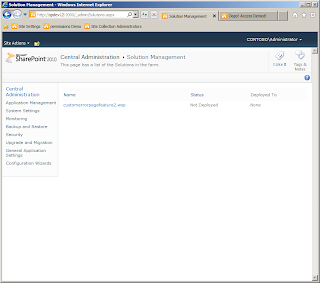Problem
You connect to Central Administration and observe a critical issue:
You click the link, View these issues, displayed in the message bar, and you see the error, The server farm account should not be used for other services, appear in the SharePoint 2010 Health Analyzer Review problems and solutions report:
Solution
This posting presented steps for resolving the health analyzer rule, The server farm account should not be used for other services. For additional details on this topic, consult the references below.
References
You connect to Central Administration and observe a critical issue:
You click the link, View these issues, displayed in the message bar, and you see the error, The server farm account should not be used for other services, appear in the SharePoint 2010 Health Analyzer Review problems and solutions report:
Solution
- Click the error link to view its description dialog:
- The error description dialog identifies the cause of the problem: the Web Analytics Data Processing Service is being run by the farm account.
- Close the dialog.
- In Central Administration, go: Security > General Security > Configure service accounts. The Service Accounts page appears.
- From the dropdown, select Windows Service - Web Analytics Data Processing Service.
- From the Select an account for this component dropdown, select a managed account other than the farm account. For this posting, the sp_app account was selected:
- Navigate back to the Review problems and solutions page, and then click the error link, The server farm accounts should not be used for other services.
- On the error description dialog, look for the button Reanalyze Now:
This launches the Health Analyzer
- Click this button. After you click this button, it will become disabled.
- Click Close. The error description dialog closes. Wait a minute or two for the Health Analyzer job to complete.
- Refresh the page: the error no longer appears:
This posting presented steps for resolving the health analyzer rule, The server farm account should not be used for other services. For additional details on this topic, consult the references below.
References
- Overview of SharePoint Health Analyzer
- Health monitoring (SharePoint Foundation 2010)
- Viewing and resolving SharePoint Health Analyzer alerts (SharePoint Server 2010)
- SharePoint Health Analyzer rules reference (SharePoint Foundation 2010)
- By default, the rule governing the Health Analyzer checking this condition runs weekly. You can verify this yourself by going: Monitoring > Health Analyzer > Review rule definitions. Look in the Category: Security group.

































































